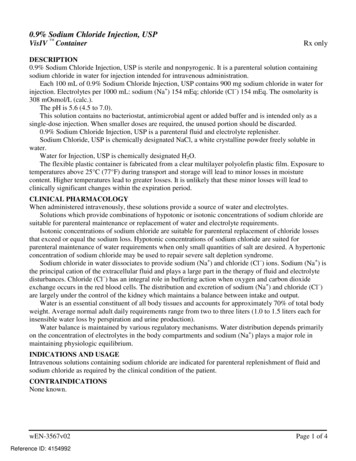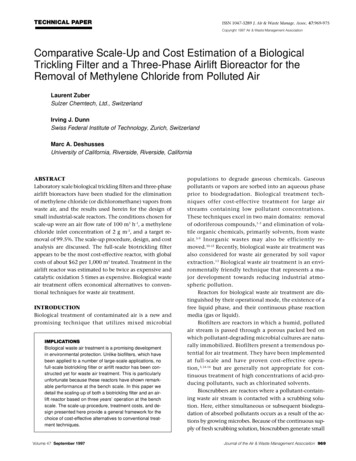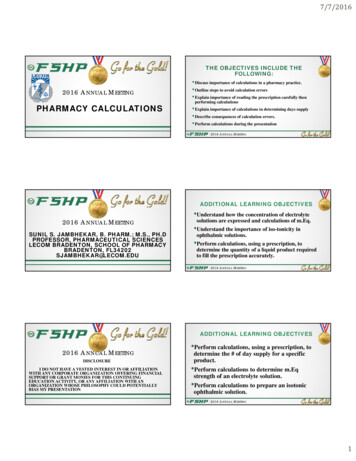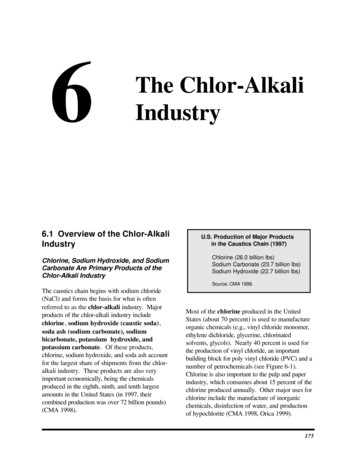
Transcription
OSHA NIOSHMethylene Chloride Hazards for Bathtub RefinishersIn February 2012, a worker using a product containing methylene chloride to refinish a bathtubwas found dead, slumped over a bathtub in an unventilated bathroom.In September 2011, a worker using a product containing methylene chloride to strip the glazefrom a bathtub collapsed in the bathtub and later died.Workers use a methylene-based stripper to removepaint from a bathtub prior to refinishing.Photo courtesy of Michigan FatalityAssessment and Control Evaluation ProgramThese types of deaths can be prevented by using alternative,less hazardous chemicals or methods that eliminate theuse of methylene chloride. If this is not possible, employerscan still prevent deaths and illnesses by using safe workpractices, such as using adequate ventilation, supplyingworkers with respiratory protection as well as protectiveclothing and equipment, and providing workers with trainingin accord with OSHA’s Methylene Chloride standard (29 CFR1910.1052) and other applicable standards, such as theHazard Communication standard (29 CFR 1910.1200) and thePersonal Protective Equipment standard (29 CFR 1910.132).Photo courtesy of California Department ofPublic HealthThe cases described above are just two of many similarcases. The Occupational Safety and Health Administration(OSHA) and the National Institute for Occupational Safety andHealth (NIOSH)-supported Fatality Assessment and ControlEvaluation (FACE) Program have identified at least 14 workerdeaths since 2000 related to bathtub refinishing with strippingagents containing methylene chloride.What is bathtub refinishing?Bathtub refinishing is the process of restoring the surfaceof an old bathtub to improve the bathtub’s appearance andrepair surface damage. The process commonly involvesremoving the bathtub’s existing finish before applying a newcoating, usually a synthetic finish such as polyurethane orepoxy. Refinishing a bathtub is a less costly alternative to fullreplacement of the fixture; however, the process often involvesthe use of hazardous chemicals including methylene chloride,acids and isocyanates.What is methylene chloride?A bathtub painted with a stripping chemical usedduring the reglazing process.Methylene chloride, a chlorinated solvent, is a volatile,colorless liquid with a sweet-smelling odor. It is often referredto as dichloromethane. Methylene chloride has many industrialuses, such as paint stripping, metal cleaning and degreasing.1-800-321-OSHA (6742) www.osha.gov11-800-CDC-INFO (1-800-232-4636) www.cdc.gov/niosh
How are workers exposed to methylene chloride?Workers are exposed to methylene chloride by breathing it in and by absorbing it through their skin. If workerssmell methylene chloride, they are being overexposed because methylene chloride cannot be smelled until thelevel in the air is higher than OSHA’s permissible exposure limits (PELs). However, the human body can quicklybecome desensitized to the smell of methylene chloride, and a worker may be overexposed even if he or shecan no longer smell it.When workers use methylene chloride to strip coatings from bathtubs, theyoften spray or pour a bathtub stripping product into the basin of the bathtub andthen brush the product onto the tub surface. Many stripping products (includingthose that may also be available to consumers), such as the one shown in thepicture at right, contain high percentages of methylene chloride. Use of thesechemicals in bathrooms is extremely dangerous, particularly because bathroomsare often small, enclosed spaces with little or no ventilation. Since methylenechloride is a volatile organic compound that will evaporate faster when sprayed,brushed, or poured, the chemical vapors can quickly build up in small spaces.Moreover, because methylene chloride evaporates quickly (it has a high vaporpressure), vapors can collect in the bottom of a bathtub and in the worker’sbreathing zone when working in the bathtub. This situation creates dangerouslyhigh concentrations of methylene chloride and even replaces the breathable air.Exposure to as little as six ounces of methylene chloride-based material has beenenough to cause death.What have investigations found?Photo courtesy of Iowa Fatality Assessmentand Control Evaluation ProgramWhy is methylene chloride a hazard for bathroom refinishers?One type of stripping productused for refinishing thatcontains methylene chloride. Using methylene chloride-based stripping agents toremove bathtub coatings. Working alone. Working in small, windowless and poorly ventilatedbathrooms. Wearing no or inadequate respiratory protectiveequipment. Wearing the wrong type of or no skin protection. Working without being trained on the hazards of exposureto methylene chloride.Photo courtesy of Maryland OccupationalSafety and HealthInvestigations of bathroom refinisher fatalities by FederalOSHA, OSHA-approved State plans,1 and the NIOSHsupported FACE program revealed common elements thatled to dangerous working conditions. Workers were:A small, poorly ventilated bathroom with no windows.How can methylene chloride affect workers’ health?When methylene chloride enters the human body, it affects brain function, such as not being able to concentrate.At high enough levels, it can stop breathing. At lower levels, methylene chloride exposure causes dizziness,fatigue, headaches, and nausea. Methylene chloride breaks down into other chemicals in the body, such ascarbon monoxide. In addition, methylene chloride can displace the oxygen in a worker’s environment because ofits high vapor pressure.Currently there are 27 OSHA-approved state occupational safety and health plans. Twenty-one states and Puerto Rico operate complete stateplans covering the private sector and state and local government employers and employees. Four states and the Virgin Islands operate state planswhich cover only state and local government employers and employees. For additional information about state plans, see: www.osha.gov/dcsp/osp/index.html.11-800-321-OSHA (6742) www.osha.gov21-800-CDC-INFO (1-800-232-4636) www.cdc.gov/niosh
The specific effects of methylene chloride exposure will vary dependingon several factors, such as the amount of methylene chloride the worker isexposed to, how long the exposure lasts, and whether the worker has a highersusceptibility (for example, having a pre-existing heart condition).In workers with heartdisease, an increase incarbon monoxide maylead to early onset heartattacks and arrhythmias(irregular heartbeats).Heart attacks may occureven before any othersymptoms of methylenechloride exposure occur. Workers exposed to methylene chloride may experience headaches,dizziness, nausea, a “feeling of intoxication,” and eye, nose and throatirritation. Prolonged skin contact may cause irritation and even chemical burns. As exposure increases so do the health effects, with the potential forsuffocation, loss of consciousness, coma and sudden death. Long-term exposure may cause cancer in humans. Animal studies haveshown that exposure to methylene chloride may lead to liver and lung cancer,as well as tumors in the breast and salivary glands. Like many cancer-causing agents, any level of exposure,even concentrations below applicable occupational exposure limits, may increase the risk of cancer.WARNING: Methylene Chloride and Stripping Products Methylene chloride-based stripping agents are EXTREMELY DANGEROUS if OSHA andstate requirements are not followed. The best way to prevent exposure is to use products that DO NOT contain methylenechloride. Consider using alternative methods, such as sanding. Care must be taken to ensure thatworkers are not overexposed to particulates being generated during sanding operations. Be aware that substitute stripping products and methods may include other harmfulchemicals or hazards, so use substitutes safely. Check product labels and safety data sheets to understand the recommended andrequired precautions. Stripping products may also contain flammable solvents andflammability may be a concern. If methylene chloride is used, follow the applicable requirements in OSHA’s MethyleneChloride standard (29 CFR 1910.1052) and other applicable OSHA standards.How can employers reduce hazards and protect bathroom refinishingworkers?Under the Occupational Safety and Health Act of 1970, employers are responsible for providing safe and healthyworking conditions for their workers.OSHA’s Methylene Chloride standard (29 CFR 1910.1052) requires employers using methylene chlorideto protect and train workers exposed to its hazards. States that operate their own occupational safety andhealth programs approved by Federal OSHA enforce similar standards but may have different or additionalrequirements. A list of state plans is available at www.osha.gov/dcsp/osp/index.html.Control Measures Bathroom fans or open windows do NOTprovide adequate ventilation. Ensure that the room is adequatelyventilated during the entire refinishingprocess. Follow all applicable OSHA standards,including the Methylene Chloride standard(29 CFR 1910.1052), as well as otherapplicable safety and health standardsand codes during bathtub stripping.Engineering Controls: OSHA requires that employers test the air formethylene chloride (see the next section onExposure Levels and Air Monitoring). Use a qualified occupational safety and healthspecialist to assist in the design and installation oflocal exhaust ventilation (LEV) to effectively controlvapors to below applicable PELs.1-800-321-OSHA (6742) www.osha.gov31-800-CDC-INFO (1-800-232-4636) www.cdc.gov/niosh
Provide local exhaust ventilation (LEV) and fresh makeup air to exhaust vapors released from the strippingagents in the bathtub. Specifically, typical mobile LEV units have a fan, flexible ductwork, and a hood near thetub that exhausts hazardous vapors to the outdoors. Ensure that the fresh make up air is fresh – not contaminated with exhausted methylene chloride vapors orother contaminants, such as car exhaust.Work Practice Controls: Avoid use of methylene chloride or minimize the amount of methylene chloride used at each site. Avoid or minimize spraying methylene chloride. Follow good housekeeping measures, including spill and leak control and appropriate personal hygienepractices (such as making skin washing areas available to workers). Use long-handled tools (e.g., scrapers, brushes) to avoid leaning into the bathtub. Leave the room immediately after applying the methylene chloride-based stripping agent to limit exposureto methylene chloride vapors. Use full-face supplied-air respirators, protective gloves, and other appropriatepersonal protective equipment (PPE) that is resistant to methylene chloride during the entire refinishingprocess.Exposure Levels and Air MonitoringOSHA’s Methylene Chloride standard (29 CFR 1910.1052) requires employers to test the air to determinethe concentration of methylene chloride present in the air when a product containing methylene chloride isused (29 CFR 1910.1052(d)). Employers must ensure that workers are not exposed to levels above OSHA’spermissible exposure limits (PELs) of 25 parts per million (ppm) over an 8-hour time-weighted average (TWA)and 125 ppm over any 15-minute period (short-term exposure limit or STEL) (29 CFR 1910.1052(c)). Thestandard also sets a 12.5 ppm action level (AL) which triggers periodic monitoring and medical surveillanceprovisions. Lowering exposures, even below the permissible exposure limit (PEL), is considered to be goodindustrial hygiene practice.Personal Protective Equipment (PPE)When engineering and work practicecontrols cannot decrease methylenechloride levels below OSHA’s PELs (25ppm over an 8-hour TWA or 125 ppm over a15-minute period), employers must providetheir workers with full-face atmospheresupplying respirators. Air-purifyingrespirators are not permitted due to theshort service life of chemical cartridges whenused for methylene chloride exposure. Halfmask respirators may NOT be used becausemethylene chloride may cause eye irritation ordamage. Whenever respirators are requiredto be worn, the employer must establish andimplement a complete respiratory protectionprogram that meets the requirements of OSHA’sRespiratory Protection standard (29 CFR1910.134), including proper selection, usage,training and medical surveillance.1-800-321-OSHA (6742) www.osha.govPhoto courtesy of Construction Safety irators:Two examples of full-face atmosphere-supplying respirators. Thesystem on the left is a full-face, pressure demand respirator witha self-contained breathing apparatus. The system on the right is acombination full face piece, pressure demand atmosphere-supplying respirator with an auxiliary self-contained air supply.41-800-CDC-INFO (1-800-232-4636) www.cdc.gov/niosh
Protective Clothing, Gloves and EyewearRegardless of the airborne exposure levels of methylene chloride, the employer must provide each worker usingmethylene chloride with, and ensure the use of, appropriate PPE to protect the worker’s eyes and skin fromexposure to methylene chloride. This includes, but is not limited to:METHYLENE CHLORIDE-RESISTANT GLOVES Gloves made of polyethylene (PE)/ethylene vinyl alcohol (EVOH), or other laminatematerials that are resistant to methylene chloride are recommended to meet therequirements of the standard. (Contact the glove manufacturer or supplier forrecommendations). Based on work activities, outer gloves are also recommendedto prevent cuts and tears to the inner methylene chloride-resistant gloves. Latex, nitrile, neoprene and polyethylene gloves do NOT protect against methylenechloride. Butyl rubber gloves are not recommended to meet the requirements ofthe OSHA Methylene Chloride standard because they typically degrade in lessthan 1 hour. Employers should ensure that workers frequently check gloves for cracks, pinholesand defects, and change gloves before breakthrough occurs.METHYLENE CHLORIDE-RESISTANT CLOTHINGLaminate gloves resistmethylene chloride fromcoming through. Methylene chloride-resistant aprons, sleeves and boots or shoe covers arerecommended to meet the requirements of the OSHA Methylene Chloridestandard to prevent methylene chloride from getting on clothing and skin. Employers must ensure that workers removeany clothing contaminated with methylenechloride. Contaminated clothing and equipmentneed to remain in a regulated area (ademarcated area where exposures to methylenechloride are expected to exceed OSHA’s PELs). Employers must then launder or dispose ofthe clothing and equipment appropriately,as outlined in Appendix A of the MethyleneImages from left to right: methylene chloride-resistant boots, faceshield, and worker wearing a methylene chloride-resistant apron,Chloride standard.safety goggles and a face shield.EYE PROTECTION Eye protection, such as goggles or a face shield, is recommended to meet the requirements of the OSHAMethylene Chloride standard in operations where respiratory protection is not required.Worker TrainingBoth OSHA’s Methylene Chloride and Hazard Communication standards2 require employers to provide healthand safety information and training to their employees. Employers must provide training to workers in amanner and language that the worker understands. The training and information must include but is notlimited to: Routes of exposure and personal protective equipment (PPE).Physical and health hazards of methylene chloride.Any operations in the work area where methylene chloride is present.Methods to detect the presence or release of methylene chloride in the work area.OSHA revised its Hazard Communication standard on March 26, 2012 (see 77 FR 17574). Although this Hazard Alert references the revisedstandard (for example, by referring to “safety data sheets” instead of “material safety data sheets”), the regulated community should refer to therevised standard to determine the effective dates of the revised standard.21-800-321-OSHA (6742) www.osha.gov51-800-CDC-INFO (1-800-232-4636) www.cdc.gov/niosh
Specific procedures implemented by the employer so that workers can protect themselves from methylenechloride exposure, such as appropriate work practices and emergency procedures to follow, and personalprotective work clothing and equipment to use. An explanation of labels, pictograms, hazard statements and safety data sheets, and how employees canobtain and use the appropriate hazard information. The quantity, location, manner of use, characteristics, release and storage of methylene chloride and thespecific operations that could result in methylene chloride exposure.In addition, employers must: Provide retraining to ensure that each worker exposed at or above the action level (AL) of 12.5 ppm (which ishalf of the OSHA PEL of 25 ppm TWA) or 15-minute short-term exposure limit (STEL) of 125 ppm maintainsan understanding of the principles of safe use and handling of methylene chloride in the workplace; and Provide updated information and training whenever there are workplace changes, such as modifications toexisting tasks or procedures or the institution of new tasks or procedures that increase employee exposure toabove the AL.MULTI-EMPLOYER WORKSITESEmployers who produce, use, or store methylene chloride in such a way that employees of other employers maybe exposed must: Provide the other employers on-site access to safety data sheets for methylene chloride; Inform the other employers of any precautionary measures that need to be taken to protect workers duringthe workplace’s normal operating conditions and in foreseeable emergencies; and Inform the other employers of the labeling system used in the workplace.Medical Surveillance, Emergency Treatment and Medical Removal Employers must make medical surveillance available for workers who are or may be exposed toconcentrations at or above the Methylene Chloride standard’s 12.5 ppm action level (AL) for 30 or more daysper year, or above the standard’s 8-hour TWA 25 ppm PEL or 15-minute 125 ppm STEL for 10 or more daysin a year (29 CFR 1910.1052(j)(1)(i)).o Appendix B of the standard describes the toxicology of methylene chloride and provides clinicians withuseful information on medical evaluation. Employers must ensure the availability of appropriate emergency medical treatment and decontamination(29 CFR 1910.1052(j)(6)(i)). Employers must provide medical removal protection benefits when a medical determination recommendsremoval because the worker’s exposure to methylene chloride may contribute to or aggravate the worker’sexisting cardiac, hepatic, neurological (including stroke) or skin disease (29 CFR 1910.1052(j)(11)).How can OSHA and NIOSH help?OSHA Consultations: OSHA provides free On-Site Consultation safety and health services for smallbusinesses with fewer than 250 workers at a site (and no more than 500 employees nationwide). This programprovides on-site compliance assistance to help employers identify and correct job hazards as well as improveinjury and illness prevention programs. On-site consultation services are separate from enforcement and donot result in penalties or citations. To locate the OSHA Consultation office nearest you, visit www.osha.gov/consultation or call 1-800-321-OSHA (6742).OSHA Compliance Assistance: OSHA also has compliance assistance specialists throughout the nationwho can provide general information about OSHA standards and compliance assistance resources. Contactyour local OSHA office for more information by calling 1-800-321-OSHA (6742) or visit OSHA’s webpage atwww.osha.gov.1-800-321-OSHA (6742) www.osha.gov61-800-CDC-INFO (1-800-232-4636) www.cdc.gov/niosh
NIOSH FACE Program: Through the FACE Program, NIOSH and state partners investigate selected workrelated fatalities to identify work situations at high risk for injury and then formulate and disseminate preventionstrategies. NIOSH and state partner FACE investigation reports and related NIOSH worker safety and healthdocuments can be accessed at the NIOSH FACE webpage at www.cdc.gov/niosh/face.NIOSH HHE Program: Employees, employee representatives, or employers can ask NIOSH to conduct HealthHazard Evaluations (HHEs) at their workplace. NIOSH may provide assistance and information by phone andin writing, or may visit the workplace to assess employee exposure and health. Based on their findings, NIOSHwill recommend ways to reduce hazards and prevent work-related illness. The evaluation is done at no cost tothe employees, employee representatives, or employers. For more information about the HHE Program, visitthe NIOSH HHE webpage at http://www.cdc.gov/niosh/hhe/default.html or contact the HHE program by phoneat 513-841-4383. For general information or questions about any hazard or illness, call the NIOSH Toll-FreeInformation Service: 1-800-CDC-INFO (1-800-232-4636).What rights do workers have?Workers have the right to: A safe and healthful workplace. Receive information and training (in a language and vocabulary they can understand) about workplacehazards, methods to prevent them, and the OSHA standards that apply to their workplace. Review records of work-related injuries and illnesses. Get copies of test results that find and measure hazards. File a complaint asking OSHA to inspect their workplace if they believe there is a serious hazard or that theiremployer is not following OSHA’s rules. When requested, OSHA will keep all identities confidential. Exercise their rights under the law without retaliation or discrimination.Federal resources with more information: Safety and Health Topics: Methylene Chloride, dex.html. This webpage describes methylene chloridehazards and OSHA’s standard for methylene chloride. Methylene Chloride, . This 2003 informational booklet provides comprehensiveguidance on the Methylene Chloride standard. Methylene Chloride Small Entity Compliance Guide Fact Sheets, ctsheets/meth facts.html. These fact sheets assist in theunderstanding of and compliance with the provisions of the Methylene Chloride standard. OSHA Methylene Chloride standard, 29 CFR 1910.1052, OSHA,http://www.osha.gov/pls/oshaweb/owadisp.show document?p table STANDARDS&p id 10094. Thisstandard covers requirements for employers to control occupational exposures to methylene chloride. NIOSH’s Workplace Safety and Health Topics: Methylene Chloride, oride. This webpage identifies different methylene chlorideinformational resources. Morbidity and Mortality Weekly Report: Fatal Exposure to Methylene Chloride Among Bathtub Refinishers– United States, 2000-2011, Centers for Disease Control and Prevention 107a2.htm?s cid mm6107a2 e. This February 24,2012, report evaluates deaths among methylene-chloride-exposed bathtub refinishers in the United Statesfrom 2000 to 2011. What You Should Know about Paint Strippers, Consumer Product Safety Commission and theEnvironmental Protection Agency, 1997 (expected to be revised in ml. This publication provides consumers and do-it-yourselfworkers with information and safety measures relating to paint stripper usage, including productscontaining methylene chloride.1-800-321-OSHA (6742) www.osha.gov71-800-CDC-INFO (1-800-232-4636) www.cdc.gov/niosh
State resources with more information: 2011 Bathtub Refinish Hazard Alert, Michigan Fatality Assessment & Control Evaluation (MIFACE)Program, gHA14.pdf. This alert summarizes workerfatalities using methylene chloride-based stripping agents in bathtub refinishing operations observed inMichigan and nationwide. 2011 Investigation Report, Michigan Fatality Assessment & Control Evaluation i/10MI013.html. This report summarizes the agency’sinvestigation of a tub refinisher who died from methylene chloride. California Department of Public Health webpage: Preventing Worker Deaths from Pain StrippersContaining Methylene Chloride. The webpage includes investigative reports on worker deaths inCalifornia, an easy-to-use guide on choosing the safest paint stripping agent, and fact sheets in bothEnglish and Spanish. 2012 Bathtub Refinisher Safety Alert, Massachusetts Fatality Assessment and Control Evaluation (MAFACE) Program, alth/bathtub-refinisher.pdf. Thisalert summarizes a bathtub refinisher death that occurred in Massachusetts and provides a list of stateand national informational resources for preventing hazards related to methylene chloride exposure atworksites. 2012 Methylene Chloride Hazard Alert, Washington State Department of Labor & Industries’ Safety &Health Assessment & Research for Prevention (SHARP) Program, lorideHazardAlert.pdf. This alert summarizes bathtub refinisher deaths from methylenechloride nationwide and provides recommendations for its discontinuing its use, as well as suggestions tofollow if methylene chloride use continues.ContactsOSHA:NIOSH:To receive documents or more information about occupational safety and health topics, please contact NIOSHat 1-800-CDC-INFO (1-800-232-4636), TTY 1-888-232-6348, email: cdcinfo@cdc.gov or visit the NIOSHwebsite.DisclaimerThis Hazard Alert is not a standard or regulation, and it creates no new legal obligations. It contains recommendations aswell as descriptions of mandatory safety and health standards. The recommendations are advisory in nature, informationalin content, and are intended to assist employers in providing a safe and healthful workplace. The Occupational Safety andHealth Act requires employers to comply with safety and health standards and regulations promulgated by OSHA or by astate with an OSHA-approved state plan. In addition, the Act’s General Duty Clause, Section 5(a)(1), requires employers toprovide their employees with a workplace free from recognized hazards likely to cause death or serious physical harm.DTSEM 01/20131-800-321-OSHA (6742) www.osha.gov81-800-CDC-INFO (1-800-232-4636) www.cdc.gov/nioshDHHS (NIOSH) Publication Number 2013-110 OSHA - HA-3623-2013For questions or to get information or advice, to report an emergency, fatality or catastrophe, to orderpublications, to file a confidential complaint, or to request OSHA’s free on-site Consultation service, contact yournearest OSHA office, visit www.osha.gov, or call OSHA at 1-800-321-OSHA (6742), TTY 1-877-889-5627.
epoxy. Refinishing a bathtub is a less costly alternative to full replacement of the fixture; however, the process often involves the use of hazardous chemicals including methylene chloride, acids and isocyanates. What is methylene chloride? Methylene chloride, a chlorinated solvent, is a volatile, colorless liquid with a sweet-smelling odor.










